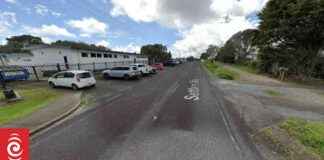Nathan Fenton: A Story of Redemption and Rehabilitation
In a quiet courtroom in Whangarei, the fate of Nathan Charles Fenton, one of Northland’s most notorious murderers, was sealed for another year as he faced a second denial of parole. The scene was a stark reminder of the tragic events that unfolded in April 2007 when Fenton, then 31 years old and a member of the Black Power gang, brutally took the life of his girlfriend, Mairina Dunn.
The details of the case are as harrowing as they are disturbing. Fenton admitted to subjecting the 17-year-old Mairina to a 90-minute beating with a sawn-off shotgun, an act of violence that left the shotgun barrel bent and the butt splintered. The brutality of the attack shocked the community and earned Fenton a life sentence with a minimum non-parole period of 17 years.
Fast forward to the present day, and Fenton, now 45, appeared before the Parole Board for a second time, hoping for a chance at redemption. Despite being described as an exemplary prisoner for the past 15 months and actively participating in mentoring young offenders through the prison’s Tuakana-Teina programme, his plea fell on deaf ears.
The Parole Board members expressed concerns about Fenton’s ability to reintegrate into society, given his lack of experience with a “pro-social life” outside of prison. They also took into account the impact of Mairina’s death on her family, who continue to grapple with the loss on a daily basis.
During the hearing, Fenton expressed remorse for his actions, acknowledging the shame he had brought upon his family and expressing a desire to turn back time. His case manager vouched for his good behavior in prison, highlighting his commitment to leaving behind his criminal past. Fenton had even attempted to meet with the victim’s family for restorative justice, though without success.
Despite these efforts, the Parole Board remained cautious, citing a psychologist’s report that assessed Fenton as having a high risk of general re-offending and a medium risk of violent offending. The board also noted the challenges Fenton faced in terms of reintegration, especially his exclusion from Auckland, where many opportunities for release-to-work programmes are located.
A Glimpse into Fenton’s Journey: Reflections and Regrets
As the hearing unfolded, Fenton offered a glimpse into his journey of self-discovery and transformation. Working with young offenders in the mentoring programme had given him a new perspective on his own life, revealing the lack of positive role models that had shaped his path. He became emotional as he reflected on his upbringing and the destructive choices he had made.
When questioned about the fatal attack on Mairina, Fenton recalled a moment of rage and violence, driven by jealousy and betrayal. He also recounted the aftermath of the assault, where he ordered others to clean up the horrific scene. These stark recollections painted a vivid picture of the events that led to his incarceration.
Looking Towards the Future: Hope and Hesitation
As the hearing drew to a close, the Parole Board set a date for a third consideration of Fenton’s parole in February 2026. In the meantime, they hoped he would be accepted into a more robust rehabilitation programme that could address his reintegration needs. Fenton’s journey towards redemption was far from over, with uncertainties lingering about his ability to transition into a pro-social member of the community.
The tragic case of Nathan Fenton serves as a stark reminder of the complexities of rehabilitation and redemption in the criminal justice system. As he faces another year behind bars, his story offers a glimpse of hope and hesitation, as he navigates the path towards a second chance at life. The road ahead is uncertain, but one thing remains clear – the journey towards redemption is a long and arduous one, filled with challenges and opportunities for growth and transformation.
In the end, the fate of Nathan Fenton rests on the delicate balance between past actions and future aspirations, as he strives to leave behind a legacy of violence and embrace a new beginning. The road to redemption may be fraught with obstacles, but with determination and resilience, even the darkest of paths can lead to the light of hope and healing.

















